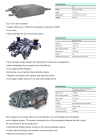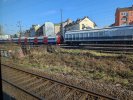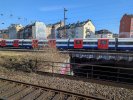The one I can see from clicking the link you provided (and also from the TfL website is dated Tuesday 28 January 2025) and doesn't include mention of the Piccadilly line this weekend, so it must have been removed since last Friday.The date of the publication is of 24th of January
-
Our new ticketing site is now live! Using either this or the original site (both powered by TrainSplit) helps support the running of the forum with every ticket purchase! Find out more and ask any questions/give us feedback in this thread!
You are using an out of date browser. It may not display this or other websites correctly.
You should upgrade or use an alternative browser.
You should upgrade or use an alternative browser.
2024 Tube Stock (Siemens Inspiro London)
- Thread starter TRAX
- Start date
Sponsor Post - registered members do not see these adverts; click here to register, or click here to log in
R
RailUK Forums
Would the train have a white light for when it uses automated signalling like the s stock does? I was just rewatching a video of the 24 ts and think the external bodyside lights are done in a more tasteful way than the S Stock because of how the lights are kind of more hidden or not so obvious to see when not activated.
ThameslinkUser
Member
They are literally there to be seen.not so obvious to see when not activated.
bluegoblin7
Established Member
How long is a piece of string? The white light implementation is unique to Seltrac, and all the trains had to be modified to support it. Given an ATO system isn’t even specified for the Piccadilly line, let alone ordered, I don’t think you need to worry about what future functionality may or may not be provided…Would the train have a white light for when it uses automated signalling like the s stock does? I was just rewatching a video of the 24 ts and think the external bodyside lights are done in a more tasteful way than the S Stock because of how the lights are kind of more hidden or not so obvious to see when not activated.
Yeah of cause when activated but I was speaking from an aesthetic point of view that the light casing/housing isn't as viewable when not activated which I thought looked good.They are literally there to be seen.
I notice the 09 stock doesn't activate the white light and the 96 stock does on the platforms but not trains. It was quite a meaningless post I posted impulsively.How long is a piece of string? The white light implementation is unique to Seltrac, and all the trains had to be modified to support it. Given an ATO system isn’t even specified for the Piccadilly line, let alone ordered, I don’t think you need to worry about what future functionality may or may not be provided…
DanNCL
Established Member
2024 stock will of course run on sections shared with the District and Metropolitan lines that were at one point expected to be re signalled with Seltrac. I don’t think it was an unreasonable question.How long is a piece of string? The white light implementation is unique to Seltrac, and all the trains had to be modified to support it. Given an ATO system isn’t even specified for the Piccadilly line, let alone ordered, I don’t think you need to worry about what future functionality may or may not be provided…
With 96 stock (and 95 stock) it’s because the trains were retrofitted for Seltrac rather than built to run on it. Iirc on the JLE it’s also linked to the platform edge doors. 09 stock uses a completely different ATO system.I notice the 09 stock doesn't activate the white light and the 96 stock does on the platforms but not trains. It was quite a meaningless post I posted impulsively.
100andthirty
Member
S Stock was retrofitted with Seltrac too. It was designed for the same signalling system as the Victoria line. The white lights were retrofitted.
Dstock7080
Established Member
S Stock were delivered with white lights as this was the indication that a PEA was operated.The white lights were retrofitted.
Last edited:
100andthirty
Member
Wow. You learn something every day!
bluegoblin7
Established Member
...but they won't use the in-cab signalling, but rather a colour-light overlay. They're conventional trains, much the same as Chiltern will operate over the Met line.2024 stock will of course run on sections shared with the District and Metropolitan lines that were at one point expected to be re signalled with Seltrac. I don’t think it was an unreasonable question.
As has been mentioned, none of the other ATO lines use the white lights in the same way, or at all. Every system is different (whether this is a good thing or not I will leave to the reader's imagination).
This was the plan before SMAs 10 11 & 12 were descoped, but as I understand it, the 'forever plan' as of today is for no Seltrac and therefore no overlays on any Piccadilly metals, just a regular lightbulbs-on-stick? Chiltern will retain an overlay eventually though....but they won't use the in-cab signalling, but rather a colour-light overlay. They're conventional trains, much the same as Chiltern will operate over the Met line.
Edit: Ah no, there will still need to be an overlay for the Piccadlly services to Uxbridge, as-planned.
Nym
Established Member
If only someone didn’t think they were really clever removing the Invensys DTG-R and Westrace contract. Then overlay wouldn’t have even been an overlay, just “another protection system” on the lockers.
OneTrackMinded
Member
On the subject of ATO, it'll be interesting to see if they restrict acceleration until a system is installed which tends to be the trend with other lines. Additionally I wonder what the acceleration of the 2024 stock will be in general. They use a SiC motor rather than IGBT, so I wonder if that'll make any difference. Hard to beat that of the S Stock and 2009 stock so I assume it'll be around the same once that ATO is installed and acceleration unlocked.
100andthirty
Member
The performance of the train will be restricted until the new signalling comes along. There might be small gains arising from modern traction equipment and modern braking. Conventional Tube signalling is designed with calculated overlaps. The principle is that engineers calculate the worst case speed a train with no passeners could be achieving when it strikes a trainstop, taking account of variable such as traction voltage, wheel diameter, gradient etc. This speed is probably unrealistically high as high traction voltage, large wheels and empty train are unlikely to happen together. The calculated speed is then used to calculate the worst case stopping distance for a crush loaded train. This distance, plus a margin for error becomes the overlap.
For the new train on existing signalling, some of the variables can be eliminated. modern traction equipment tends to provide a constant performance irrespective of voltage (within limits of course!) and the tractive effort curves can be set, so, for example, there could be a very high rate of acceleration up to, say, 30 mph with a ceiling on speed. This is what was done for S stock prior to ATO. Another feature will be 8 motored bogies (out of 10) on the new train compared with 8 out of 12 on the 1973 tube stock. This means better uses of the available adhesion will be possible.
By the way, when a new signalling system does come along similar principles will be used to calculate safe spacing between trains
Finally, 1973 tube stock was always capable of much higher performance than it was ever able to use in service, but was demonstrated when first tested in 1974.
The IRSE published a paper/presentation about safe braking principles for ATO in 2024 which was summarised in a Rail Engineer article: https://www.railengineer.co.uk/demystifying-the-safe-braking-model/
For the new train on existing signalling, some of the variables can be eliminated. modern traction equipment tends to provide a constant performance irrespective of voltage (within limits of course!) and the tractive effort curves can be set, so, for example, there could be a very high rate of acceleration up to, say, 30 mph with a ceiling on speed. This is what was done for S stock prior to ATO. Another feature will be 8 motored bogies (out of 10) on the new train compared with 8 out of 12 on the 1973 tube stock. This means better uses of the available adhesion will be possible.
By the way, when a new signalling system does come along similar principles will be used to calculate safe spacing between trains
Finally, 1973 tube stock was always capable of much higher performance than it was ever able to use in service, but was demonstrated when first tested in 1974.
The IRSE published a paper/presentation about safe braking principles for ATO in 2024 which was summarised in a Rail Engineer article: https://www.railengineer.co.uk/demystifying-the-safe-braking-model/
From brief research I know that SiC motors are probably lighter in weight. I'm not yet sure of other advantages. I think quieter???On the subject of ATO, it'll be interesting to see if they restrict acceleration until a system is installed which tends to be the trend with other lines. Additionally I wonder what the acceleration of the 2024 stock will be in general. They use a SiC motor rather than IGBT, so I wonder if that'll make any difference. Hard to beat that of the S Stock and 2009 stock so I assume it'll be around the same once that ATO is installed and acceleration unlocked.
I've also seen this https://www.reddit.com/r/LondonUnde...on_underground_2024_stock_supports_permanent/
So I wonder if it would sound similar to these trains in any way
100andthirty
Member
I think there are two features being conflated. SiC motors are referred to. SiC refers to silicon carbide, a material that can be used to make semiconductors which might be used in the solid state traction controllers, instead of IGBTs. I understand that the motors themselves are be permanent magnet type. Both innovations promise to be a little more energy efficient than the traditional silicon semicnductors and ac induction motors. The noises that the train might make depend heavily on the frequencies used by the traction drives and the gear ratios in the gearboxes.
Noise is also a function of efficiency. Energy is required to move air at any frequency — also known as "making a sound".Both innovations promise to be a little more energy efficient than the traditional silicon semicnductors and ac induction motors. The noises that the train might make depend heavily on the frequencies used by the traction drives and the gear ratios in the gearboxes.
boiledbeans2
Member
I think there's further confusion in this post. IGBTs can be made of SiC as well. Here's a publication comparing Si IGBT and SiC IGBTs:I think there are two features being conflated. SiC motors are referred to. SiC refers to silicon carbide, a material that can be used to make semiconductors which might be used in the solid state traction controllers, instead of IGBTs. I understand that the motors themselves are be permanent magnet type. Both innovations promise to be a little more energy efficient than the traditional silicon semicnductors and ac induction motors. The noises that the train might make depend heavily on the frequencies used by the traction drives and the gear ratios in the gearboxes.
Power Performance Comparison of SiC-IGBT and Si-IGBT Switches in a Three-Phase Inverter for Aircraft Applications - PMC
The converters used to integrate the ground power station of planes with the utility grid are generally created with silicon-insulated gate bipolar transistor (Si-IGBT)-based semiconductor technologies. The Si-IGBT switch-based converters are ...
I'm not familiar with the 2024 stock to understand what's on it. With some googling, my guess is that they are using SiC MOSFETs.
Last edited:
OneTrackMinded
Member
100andthirty
Member
That's a really useful post. Thanks
D365
Veteran Member
- Joined
- 29 Jun 2012
- Messages
- 12,132
What’s the source document please.Here's the tech sheet
View attachment 174252
This is cutting edge tech and, as stated, Siemens' first for rail vehicles in series production.
Dstock7080
Established Member
That’s currently true, although a 6-car 1973 Stock has recently visited Ruislip depot to undertake coupling tests with 2024 Stock, the usual couplers are incompatible (Auto - Scharfenberg).
So this is moving forward for on Line testing in immunised areas.
So this is moving forward for on Line testing in immunised areas.
Deleted.Is my understanding correct that the trains haven’t entered regular testing yet and hence are already quite unlikely to enter into service this year?
Last edited:
There was an interesting video about the Siemens Goole factory on YouTube yesterday - Siddy Holloway takes a walk around chatting to a manager and looking at the facilities.Unit no. 004 has been spotted in Cologne, Germany.
YouTube link to video.
Photo makes the door bezels look much more defined than in other photos.Unit no. 004 has been spotted in Cologne, Germany.
View attachment 175046View attachment 175047
Photos via user GaddockTeegFunPolice on Reddit.
Small thing but I wondered why the does have speakers on them. I saw this in some video or photo.
Do you mean doors? I have no knowledge, but would guess at door chimes?ll thing but I wondered why the does have speakers on them. I saw this in some video or photo.



